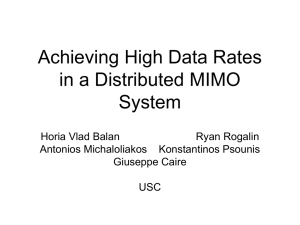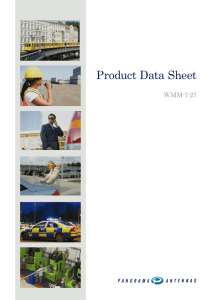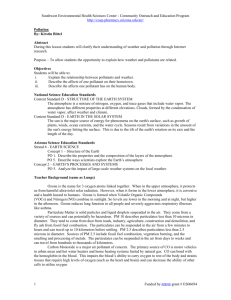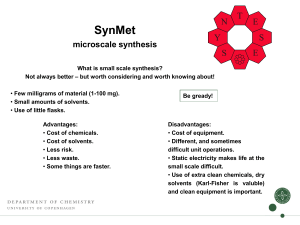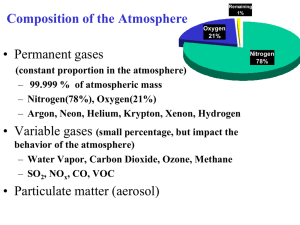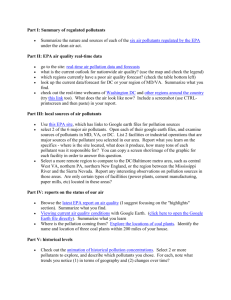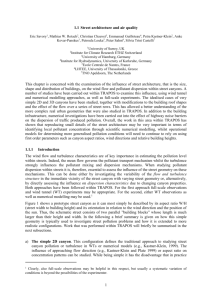CEST2015_sample_full_paper
advertisement
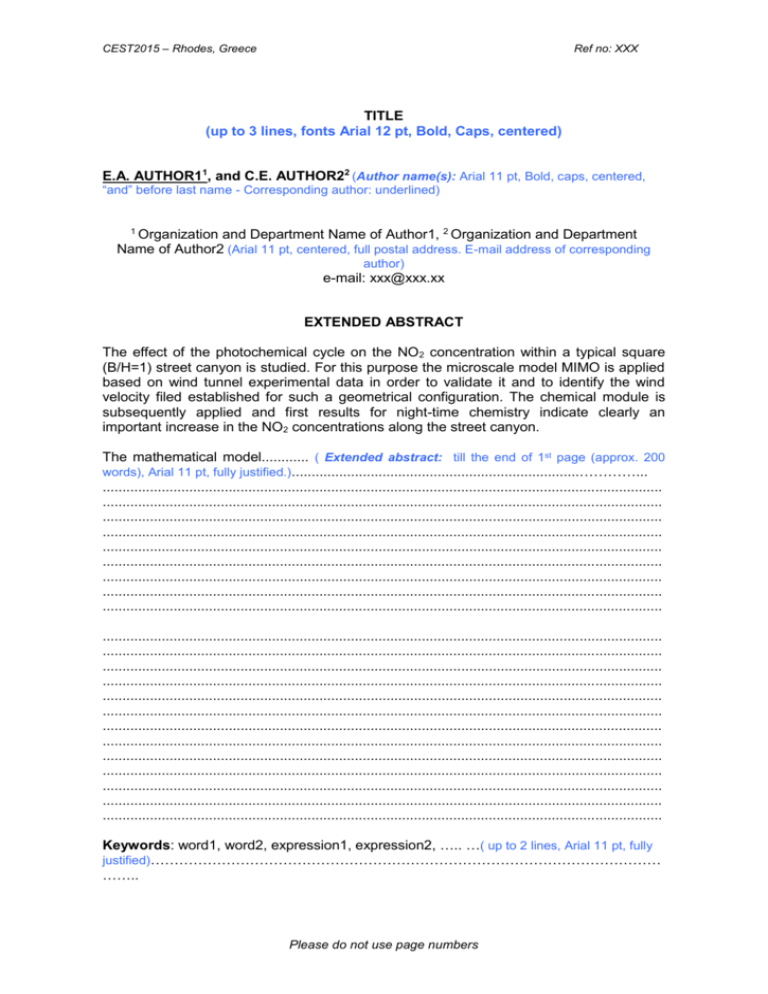
CEST2015 – Rhodes, Greece Ref no: XXX TITLE (up to 3 lines, fonts Arial 12 pt, Bold, Caps, centered) E.A. AUTHOR11, and C.E. AUTHOR22 (Author name(s): Arial 11 pt, Bold, caps, centered, “and” before last name - Corresponding author: underlined) 1 Organization and Department Name of Author1, 2 Organization and Department Name of Author2 (Arial 11 pt, centered, full postal address. E-mail address of corresponding author) e-mail: xxx@xxx.xx EXTENDED ABSTRACT The effect of the photochemical cycle on the NO2 concentration within a typical square (B/H=1) street canyon is studied. For this purpose the microscale model MIMO is applied based on wind tunnel experimental data in order to validate it and to identify the wind velocity filed established for such a geometrical configuration. The chemical module is subsequently applied and first results for night-time chemistry indicate clearly an important increase in the NO2 concentrations along the street canyon. The mathematical model............ ( Extended abstract: till the end of 1st page (approx. 200 words), Arial 11 pt, fully justified.).........................................................................…………... .............................................................................................................................................. .............................................................................................................................................. .............................................................................................................................................. .............................................................................................................................................. .............................................................................................................................................. .............................................................................................................................................. .............................................................................................................................................. .............................................................................................................................................. .............................................................................................................................................. .............................................................................................................................................. .............................................................................................................................................. .............................................................................................................................................. .............................................................................................................................................. .............................................................................................................................................. .............................................................................................................................................. .............................................................................................................................................. .............................................................................................................................................. .............................................................................................................................................. .............................................................................................................................................. .............................................................................................................................................. .............................................................................................................................................. .............................................................................................................................................. Keywords: word1, word2, expression1, expression2, ….. …( up to 2 lines, Arial 11 pt, fully justified)……………………………………………………………………………………………… …….. Please do not use page numbers 1. INTRODUCTION In the past decades, one of the issues that have attracted increased attention is the degradation of air quality in urban, and therefore, densely populated areas. The aggregation of human activities, especially in these areas of insufficient ventilation, recurrently leads to pollutant concentration levels much higher than the limits set by the World Health Organisation, the EU or the local government. The dispersion of pollutants in urban environments is dominated by the wind flow around complex building structures. Down-wash phenomena and increased local turbulence strongly influence not only the mean flow field but also the diffusion parameters. A typical configuration is the so-called street canyon, formed along a street in a densely built urban area. At the bottom of a street canyon, the vehicles emit gaseous pollutants in the form of buoyant plumes. Under certain conditions, e.g. for non-zero wind component perpendicular to the street, higher concentration levels are observed on the leeward than on the windward side of the street canyon. Due to their rather coarse resolution mesoscale models can not predict those influences accurately. Furthermore, chemical reactions with small time-scales, which take place in the street canyon area immediately after emission, can have a decisive effect on the composition of the pollutants before scales are reached which are comparable to the resolution of mesoscale models. Microscale models take explicitly into account building structure and are able to predict wind fields and dispersion of pollutants within urban areas and can, therefore, indicate areas of high pollutant concentration in the vicinity of buildings. Moreover, microscale models, taking into account such chemical processes as NO-NO2-O3 fast cycles, can provide mesoscale models with more accurate emission data. Atmospheric flow and pollutant dispersion over urban areas are affected by phenomena belonging to different scales. Regional transport and the flow in the upper part of the planetary boundary layer are mainly determined by mesoscale phenomena. Flow, turbulence and pollutant dispersion near the surface are, however, decisively influenced by single or clusters of obstacles such as buildings or street canyons. Hence, multiscale model systems are being developed, starting at local-to-regional scale and going down to the microscale. An example of such a model system is ZEUS, which is currently under development at the Aristotle University of Thessaloniki, based on the mesoscale model MEMO (Flassak, 1990) and the microscale model MIMO. The incentive behind ZEUS is that each scale provides the next smaller one with appropriate lateral boundary conditions for momentum, heat flux and pollutant concentrations. Microscale parametric computations provide improved momentum, heat and pollutant vertical fluxes as input to the larger scales. Within that frame, the microscale model MIMO (Ehrhard et al., 2000) was selected and validated against wind tunnel experimental data from a two-dimensional multiple cavity case. Subsequently a fast chemistry module was implemented in order to study the effects of such chemical reactions on the NO2 concentrations, as this pollutant is harmful to human health. 2. MICROSCALE MODEL DESCRIPTION The microscale model MIMO is a three-dimensional model for simulating microscale wind flow and dispersion of pollutants in built-up areas. It solves the Reynolds averaged conservation equations for mass, momentum, energy and other scalar quantities such as the humidity or the concentration of pollutants. The conservation equation of mass is formulated in terms of the pressure, yielding an elliptic differential equation. The discrete form of the elliptic equation is solved using a preconditioned conjugate gradient (CG) method. In order to solve for the averaged conservation equations it is necessary to model the unknown Reynolds stresses, which arise from the averaging of the non-linear transport equations, with the aid of turbulence models. The most common turbulence models are based on the eddy viscosity hypothesis by Boussinesq. Depending on the desired accuracy and effort several turbulence models can be applied by MIMO. The standard k-equation turbulence model is used for this particular study. For the numerical treatment of advective transport a three-dimensional second-order fluxcorrected transport scheme (FCT) is applied. Within MIMO a finite volume discretisation procedure is adopted for solving the governing equations on a staggered grid arrangement. Coordinate transformation is applied to allow non-equidistant mesh size in all three dimensions in order to achieve a high resolution near the ground and near obstacles. In the model MIMO two different possibilities for the initialisation are included. The first possibility is to couple the microscale model MIMO with the mesoscale model MEMO. Alternatively the initial wind field can be calculated from measured data or by applying the power law. 3. CALCULATIONS PERFORMED 3.1. Case specifications and boundary conditions The case considered in this contribution has been studied experimentally (Rafailidis and Schatzmann, 1995; 1997) In these experiments, wind tunnel models, corresponding to multiple street-canyon configurations with a variety of canyon aspect (street width B to building height H) ratios and roof shapes, were placed in a simulated deep urban boundary layer (see Figure 1). Between two of the buildings, a steady line source S extending across the tunnel was placed. Concentrations were measured at various locations of the neighbouring walls. The wind was orthogonal to the direction of the street and there were buildings at regular intervals both upstream and downstream of the street containing the source in order to simulate an urban roughness. Tests were performed with B/H=1 and with B/H=1/2. In each case measurements of the concentrations were made in the symmetry plane of the set-up using a Laser light sheet visualisation method, with different combinations of roofs neighbouring the street containing the source. The concentrations were made non-dimensional by utilising the following formula: K=CULH/Q, where C [vol/vol] denotes the tracer concentration, U [m s-1] is the free stream velocity (5 m s-1), H [m] is the building height, L [m] is the length of the line source and Q [vol/s] the source strength. The initial wind field was calculated from velocity and turbulence intensity profiles that were measured along vertical lines over the roofs at several locations. The computational domain consists of five street canyons. At the main inflow boundary, the profiles of the horizontal velocity u, the turbulent kinetic energy k and conditions, while zero values are assigned to the vertical wind velocity v and the concentration C. At the outflow boundary, the gradients with respect to the streamwise direction are set to zero. At solid walls the no-slip condition is applied. The free-stream horizontal boundary is placed at a distance of 7H over the flat building roofs. Figure 1. Illustration of the two-dimensional experimental set up. 3.2. Fast chemistry It has been suggested by other researchers (Palmgren, 1996) that transport and dispersion processes are not the only factors determining source-receptor relationships in urban areas. Chemistry plays an important role in the transformation of pollutants, resulting in degradation of some species and formation of others. Especially inside street canyons where due to the very short distances between sources and receptors and the relatively short residence times of the emitted pollutants, only the fastest chemical reactions can have a decisive effect on the transformation processes of the air mass. Of these fast chemical reactions the photochemical cycle, NO-NO2-O3, is of particular interest as it leads to increase of the NO2 concentration, a pollutant which is considered to be harmful to human health. A module for the coupled treatment of fast chemical reactions within street canyons has been developed based on the NO-NO2-O3 cycle: ……………….. ……………… …………………………………………………………………………………………………… …………………………………………………………………………………………………. 4. RESULTS 4.1. Comparison with experimental data The case studied for the purposes of this contribution was the square canyon (B/H =1), due to the simplicity of the flow filed evolved which would subsequently be used for the application of the fast chemistry module. Furthermore MIMO should be validated against experimental data. ……………………………………………………………………………………………………… ……………………………………………………………………………………………………… ……………………………………………………………………………………………………. 4.2. Fast chemistry calculations The same case specifications and boundary conditions were adopted for the fast chemistry calculations. The NOx emission rate was assumed to be 1250 μg m-3sec and O3 concentrations ranged from 30 ppb to 70 ppb. The ratio of NO2/NOx was set to 5% following the suggestions of other researchers. In figures 4,5 and 6 the effect of the chemical reactions taking place immediately after emission is clearly seen for the leeward wall, the centre of the cavity and the windward wall respectively. ……………………………………………………………………………………………………… ……………………………………………………………………………………………………… ……………………………………………………………………………………………………… ……………………………………………………………………………………………………… ……………………………………………………………………………………………………… ……………………………………………………………………………………………………… ……………………………………………………………………………………………………… ……………………………………………………………………………………………………… 5. CONCLUSIONS The microscale model MIMO was validated against wind tunnel experimental data. Having established its satisfactory performance a fast chemistry module was created and embodied with MIMO in order to study the effects on the concentration of NO 2. It was found that for night-time conditions with a steady background O3 concentration NO2 rises. The relationship between the NO2/NOx ratio is almost linear and it rises with higher background O3 concentration. Furthermore, it was found that the ratio varies along the canyon rising dramatically from the leeward wall to the windward wall, whereas maximum NOx concentrations are met at the leeward wall. Further work will be performed in order to study daytime chemical reactions and their effect on NO2 concentrations within street canyons. ……………………………………………………………………………………………………… ……………………………………………………………………………………………………… REFERENCES 1. 2. 3. 4. 5. 6. 7. Assimakopoulos V., Moussiopoulos N. and Apsimon H.M. (2000), Effects of Street Canyon Geometry on the Dispersion Characteristics in Urban Areas, 16th IMACS World Congress 2000, August 21-25 2000 Lausanne, Switzerland. Ehrhard J., Khatib I.A., Winkler C., Kunz R., Moussiopoulos N. and Ernst G. (2000) The microscale model MIMO: development and assessment, J Wind Eng. Ind. Aerodyn., 85, 163176. Flassak T. (1990) Ein nicht-hydrostatisches Modell zur Berechnung der Dynamik der planetaren Grenzschicht, Fortschritt-Berichte VDI, Reihe 15, Nr.74, VDI-Verlag Duesseldorf. Moussiopoulos N., Theodoridis G. and Assimakopoulos V. (1998), The influence of fast chemistry on the composition of NOx in the emission input to atmospheric dispersion models, Proceedings from the EUROTRAC-2 Symposium 1998. Palmgren F., Berkowicz R., Hertel O. and Vignati E. (1996) Effects of reduction of NO x on NO2 levels in urban streets, Sci. Total Environ., 189/190, 409-415. Rafailidis S. and Schatzmann M. (1995) Concentration Measurements with different roof patterns in street canyons with aspect ratios B/H=1/2 and B/H=1, Report, Meteorology Institute, University of Hamburg. Rafailidis S. and Schatzmann M. (1997) URL: http://www.mi.uni-hamburg.de /technische_meteorologie/windtunnel/street02/overview.html (accessed xx/xx/2008)


